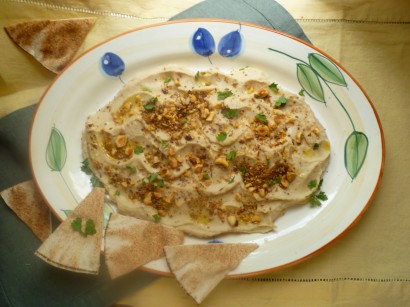No Reviews
You must be logged in to post a review.

“Well, you can have your yams, you can have your collard greens; but if you want to please little ol’ me, you better fix butterbeans.” ThisB-52’s musical tribute is to the butterbean in its pristine form. But in a spreadable variation, sprinkled with dukkah (an Egyptian condiment of herbs, nuts and spices), the little bean may have folks wishing to second those immortal words of B-52: “Pass me a plate full, I’ll be grateful.”
You will also need for the spreadable butter beans:
1. A food processor.
2. A platter for the finished bean spread.
You will also need for the dukkha:
1. A rimmed baking pan.
2. A cast-iron pan or other heavy-bottomed pan.
3. A mortar and pestle: crushing the nuts and seeds in a mortar with a pestle gives the dukkah its characteristic consistency.
4. Three small bowls to hold roasted seeds and a medium bowl in which to mix the dukkah.
For the spreadable butter beans:
1. Put the drained beans in the food processor with the garlic, lemon juice, half the olive oil, half of the 1/3 cup of reserved bean liquid, the salt and a few grinds of black pepper.
2. Turn on the processor and gradually add the rest of the olive oil. Then begin adding the rest of the bean liquid until the mixture forms a smooth purée. (Given the slight variations in can sizes, a little less than the full 1/3 cup of bean liquid may be enough. Therefore, add the second half of the liquid gradually.)
3. Transfer the bean spread to a bowl; cover it. Set it aside at room temperature if it is being served fairly soon. If made a day ahead, refrigerate it and bring it to room temperature before serving.
4. To serve: Arrange the bean purée on a platter and make a wavy line pattern over its surface with the back of a spoon. Drizzle it with a little olive oil and sprinkle a few spoonfuls of dukkah over it. (The recipe for the dukkha is given below.) Scatter some parsley on it as well. Serve the bean spread and dukkah with fresh pita triangles or with the herbed and spiced pita chips, described in the related link.
For the dukkah:
1. Preheat the oven to 285 F. Spread the hazelnuts on the baking tray and toast them for 10 minutes. After 10 minutes, add the sunflower seeds to the tray, keeping them separate from the hazelnuts, and toast both the hazelnuts and the sunflower seeds for 10 more minutes. Take them from the oven and cool them.
2. Heat the cast iron pan over medium heat for about 5 minutes. Add the fennel seeds and roast them for about 30 seconds. Add the cumin seeds and roast for another 30 seconds, or until they begin to pop in the pan. Pour the seeds into a small bowl and set them aside.
3. Add the peppercorns to the pan and heat them until they start to pop. Put them in a second small bowl.
4. Add the coriander seeds to the pan and roast until they begin to pop and place them in the third small bowl.
5. Rub the hazelnuts between the palms of your hands to remove the skins. Place the nuts in the mortar and crush them coarsely with the pestle. Pour them into the medium-sized bowl. Add the cumin and fennel seeds to the mortar and crush them lightly. Add them to the medium sized bowl as well.
6. Crush the coriander seeds lightly with the mortar and pestle; add them to the medium bowl. Crush the peppercorns, and then, the sunflower seeds. Add each to the medium bowl after crushing.
7. Add the sesame seeds, salt and paprika to the crushed nuts and seeds and stir everything together well.
A note about storing dukkah:
1. Dukkah will keep well for months stored in a sealed glass jar if kept in a cool, dry place.
An acknowledgement: Both the spreadable butter beans and the dukkah are adapted from recipes by Yotam Ottolenghi that appeared in his column in “The Guardian”.
No Comments
Leave a Comment!
You must be logged in to post a comment.